Midweek Review
Impact of foreign-funded projects on Parliament’s standing as sole sovereign and supreme body
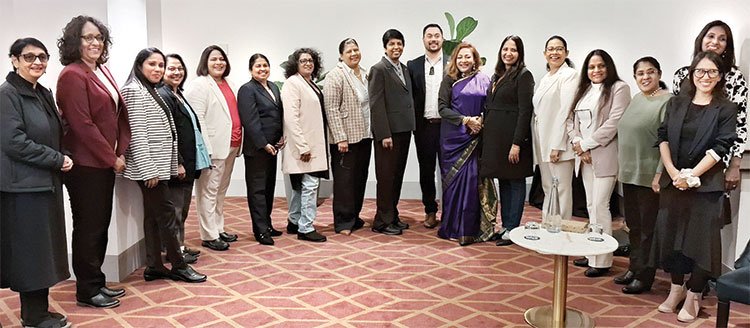
Yahapalana Speaker Karu Jayasuriya’s plea for Indian funding to develop Elapathagama in the memory of the late Maduluwawe Sobitha Thera remains a mystery. In terms of an agreement signed on 14 July, 2017, India provided Sri Lankan
Rs 300 mn to develop Elapathagama in the Anuradhapura district. The late Sobitha Thera, a controversial character, spearheaded a high profile campaign that facilitated the UNP-led Opposition strategy meant to thwart Mahinda Rajapaksa securing a third presidential term.
By Shamindra Ferdinando
Actress Shalani Tharaka dominated electronic, print and social media recently after the shocking disclosure that Sri Lanka Cricket heavyweight Jayantha Dharmadasa recommended her for an Australian visa among other faux pas committed by the cavalier SLC Executive Committee.
The revelation, based on Auditor General W.P.C. Wickremaratne’s draft report on the country’s disastrous T-20 World Cup tour of Australia late last year, embarrassed the SLC. The SLC is yet to respond to a spate of questionable ‘transactions’ raised by the National Audit Commission in its draft report handed over to Sports Secretary K. Mahesen. That report is evidence that the SLC bosses spent funds at will in spite of being answerable to Parliament.
Then versatile singer Umara Sinhawansa upstaged model Tharaka, who captured the media limelight in 2007 as ‘Sirasa’ Kumariya. Sinhawansa earned the wrath of the nationalists for the way she sang the national anthem at the opening of LPL at the R. Premadasa stadium, Khettarama, on Sunday (30 July). Social media exploded over the issue at hand while the government sought the advice of Attorney General Sanjay Rajaratnam, PC, in this regard.
Would Umara have received such negative coverage if she had not performed live at the invitation of SLC, under heavy fire over squandering of funds? It would be pertinent to ask how much Umara received for her controversial singing of the national anthem. Perhaps the Auditor General would raise that issue later with the SLC. Most probably she put in her sincere best effort, without knowing some of the key words in the national anthem. May be the blame should go to our education system and those at SLC who should have whetted her performance, in advance. The whole issue should be examined against the backdrop of Sports Minister Roshan Ranasinghe’s claim that SLC didn’t even bother to consult him regarding the LPL tournament. But another issue is how much Umara Sinhawansa’s particpation at the LPL opening cost SLC.
The draft report underscored the failure on the part of Parliament to discipline the richest sports body in the country. In fact, the reports issued by the National Audit Commission, over the past several years, reveal the pathetic failure on the part of our supreme legislative body the Parliament at all levels.
Close on the heels of the continuing controversy over Umara who’s younger sister Umariya received the honour of singing ‘Hanthane Sihine’ with the late maestro W.D. Amaradewa a few years ago.
Meanwhile the Women Parliamentarians’ Caucus’ visit to New Zealand also grabbed public attention. So much so, Secretary General of Parliament Kushani Rohanadeera issued a brief statement to explain the position of the Parliament. Rohanadeera insisted that public funds weren’t utilized. The funding was provided by Sri Lanka’s development partners. The initiative, launched two and half years ago, never received public funding and the visit was meant to gain experience from developed countries in the Commonwealth.
The group consisted of Dr. Sudarshini Fernandopulle (SLPP), Dr. Sitha Arambepola (SLPP), Rohini Kumari Wijeratne (SJB), Pavithradevi Vanniarachchi (SLPP), Geetha Samanmalee Kumarasinghe (SLPP), Thalatha Atukorale (SJB), Kokila Gunawardena (SLPP), Mudita Prishanthi (SLPP), Rajika Wickramasinghe (SLPP), Manjula Dissanayake (SLPP) and. (Dr.) Harini Amarasuriya (JJB). Secretary General of Parliament Kushani Rohanadeera, Assistant Director (Administration) Indira Dissanayake and Media Manager of Parliament Nimmi Hathiyaldeniya accompanied the delegation. Having left the country on 24th July, the group concluded the visit on 3rd August.
The Island
sought an explanation from the Chairperson of the Women Parliamentarians’ Caucus Dr. Sudharshini Fernandopulle. The Gampaha District parliamentarian said that the Secretary General would have issued a statement in response to media queries in this regard. The lawmaker added: “New Zealand was selected because they have 50% women’s representation in Parliament, as well as in Cabinet. They also have an electoral system, known as Multi Member Representation, where people have two votes – one for the party and the other for the candidate. This system ensures representation by small parties, too. This high representation has been introduced by reforms within political parties where they have fielded more female candidates.”
A few years ago, the media wouldn’t have raised such a visit. But the conduct of members of Parliament and especially their foreign visits are increasingly coming under public scrutiny against the backdrop of the country being declared bankrupt in April 2022 and unprecedented deterioration of parliamentary standards over a period of time. (During the war various interests sought to influence MPs by arranging foreign tours. They felt public opinion can be manipulated by winning over MPs)
NZ tour courtesy USAID
In a trilingual statement, dated 02 August, the Parliament explained how the required funding for this year’s tour was obtained. The National Democratic Institute (NDI), with the funding provided by the United States Agency for International Development (USAID), has organized the tour undertaken by the Women Parliamentarians’ Caucus for the advancement of Sri Lankan women at every level.
In addition to the USAID, the NDI works closely with the National Endowment for Democracy, the U.S. Department of State and the Consortium for Elections and Political Process Strengthening (CEPPS). The above-mentioned organisations are well known around the world for sponsoring such initiatives, in line with furthering US interests.
During the nearly 10-day visit, Dr. Fernandopulle’s group had an opportunity to meet New Zealand’s first woman Prime Minister Helen Clark as well as Jacinda Ardern who created waves as the Premier from 2017 to 2023. They shared their experience with the visiting MPs, with Ardern focusing on the challenges she faced in the face of the economic and political crises, as well as the Covid-19 pandemic, during her tenure.
Political parties, represented in Parliament, should seriously examine whether the country benefited from foreign tours received by its members. Let me stress that such an appraisal shouldn’t be restricted to the Women Parliamentarians’ Caucus. Unfortunately, Parliament has never been bothered with such examinations though a section of the media raised the accountability on the part of the House to provide proper audit of foreign grants.
Perhaps Parliament can explain the outcome of the high profile USAID project worth Rs. 1.92 billion (USD 13.7 million), launched in late November 2016, during Karu Jayasuriya’s tenure as the parliamentary Speaker during the Yahapalana government.
The USAID, partnered with the Parliament, and the first project of its kind, was meant to strengthen accountability and democratic governance. Interestingly, USD 3 mn had been released in September 2016 before the official launch of the project.
Parliament announced the USAID project in the wake of Sri Lanka becoming the newest member of the United States’ House Democracy Partnership programme which purports to support peer-to-peer exchanges for partner legislatures around the world.
By then the massive Treasury bond scams had been perpetrated twice in late February 2015 and March 2016 while the fugitive Governor of the Central Bank, Singaporean Arjun Mahendran, later indicted in the High Court of Colombo, had still not fled the country.
Actually, Karu Jayasuriya, the incumbent head of the National Movement for Social Justice (NMSJ), certainly owes an explanation as to the progress made in terms of the three-year Strengthening Democratic Governance and Accountability Project (SDGAP) geared to improve strategic planning and communication within government and Parliament, enhance public outreach, develop more effective policy reform and implementation processes, and increase political participation of women and underrepresented groups in Parliament and at local level.
The people have a right to know how the USAID funds were spent and whether stated objectives were achieved, especially in light of former US Secretary of State John Kerry having crowed about how they brought about undemocratic secret regime changes here and elsewhere after spending hundreds of millions of dollars.
Maryland headquartered Development Alternatives, Inc (DAI) implemented the project intended to reform the public sector in accordance with an agreement between Sri Lanka and the House Democracy Partnership of the US House of Representatives.
During the implementation of that USAID project, Speaker Jayasuriya had retained retired controversial career diplomat Prasad Kariyawasam as his advisor. Kariyawasam, who had served as the Foreign Secretary after being Sri Lanka’s Ambassador in Washington, was on the USAID payroll. Kariyawasam earned the wrath of the JO/SLPP and various other parties. They accused him of promoting US interests, both in and outside Parliament. Even as Sri Lanka’s Ambassador in Washington, he figured in a rather embarrassing press conference with TNA Parliamentarian M.A. Sumanthiran claiming that there was a triparite agreement on the setting up of hybrid court to investigate accountbaility issues.
Having failed in its bid to elect General Sarath Fonseka at the 2010 presidential election, the US played a role in the change of government in January 2015. No less a person than the then US Secretary of State, John Kerry, who visited Colombo, in May 2015, is on record as having said that the US-funded restoration of democracy (read clandestine change of governments) in Nigeria, Myanmar and Sri Lanka. The State Department referred to USD 585 mn as the cost of those clandestine projects.
May be due to such continuing underhand interventions of the US, Sri Lanka ended up bankrupt and the incumbent Governor Dr. Nandalal Weerasinghe had to officially acknowledge the country’s pathetic status in April 2022. The economic fallout should be examined taking into consideration the circumstances the Yahapalana administration (2015- 2019) obtained International Sovereign Bonds (ISBs) to the tune of USD 12.5 bn.
Interestingly, Auditor General W.P.C. Wickramaratne exposed the massive disparity between the above such borrowings and lack of corresponding assets when he addressed a workshop for parliamentarians recently
According to the Auditor General, Sri Lanka has taken project loans, amounting to eight trillion in rupee terms ,since 2015, but the country has corresponding assets worth only two trillion rupees to show, leaving a black hole of six trillion rupees.
According to a report in the Sunday Times BUSINESS of 30 July, Wickramaratne was quoted as having stated that this cannot be acceptable by any accounting standards and that loans are recorded as liabilities on the borrower’s balance sheet.
The explanation given for this disparity by state officials was that they were in the process of assessing the assets, he has revealed, adding that even after eight years the country was unable to identify the corresponding assets.
Like in the case of the CB bond scam we may not see any justice in our life time the way the system works, but even if this was a robbery of six trillion marbles it is certainly no small matter.
The Sunday Times BUSINESS, in a separate report headlined “Loophole for money launderers in Foreign Exchange Act” says a gaping loophole in the six-year-old Foreign Exchange Act (introduced by the Yahapalana government) is damaging the country’s fight against money laundering.
Enacted in 2017 after repealing the 1953 Exchange Control Act, it quotes unnamed experts as stating that the Act does not have provisions to regularise foreign exchange transfers.
Accountability of Parliament
On the request of Yahapalana Speaker Jayasuriya, China arranged familiarisation tours for members of Parliament. Tours began about 10 weeks after the August 2015 General election. Altogether 11 batches of MPs, accompanied by officials, visited China from Oct0ber 2015 to July 2019. Following their return, the then Chinese Ambassador in Colombo Cheng Xueyuan hosted a grand reception for the parliamentarians.
In addition to them, a group of journalists, covering Parliament, too, were included in the deal. Did the country benefit in any way from these junkets?
During the period the groups of lawmakers toured China, the emerging power finalized the controversial deal on the Hambantota port. Then Prime Minister Ranil Wickremesinghe, who had been openly critical of Chinese policy here, ended up leasing the port for a period of 99 years. In spite of the government repeatedly claiming that the leasing was meant to raise the funds required to settle loans, taken from China to build the port, subsequently it was revealed USD 1.2 bn received from China was utilized for other purposes. When the Committee on Public Enterprises (COPE) raised this issue with Sri Lanka Ports Authority (SLPA), it didn’t even know how USD 1.2 was spent. The then Ports and Shipping Minister Arjuna Ranatunga resigned after having refused to sign the lease agreement. But President Maithripala Sirisena brought in Mahinda Samarasinghe as the Shipping Minister to authorize the deal. Finally, Samarasinghe who entered Parliament on the SLPP ticket, at the last general election, in August 2020, received appointment as our Ambassador in Washington.
Speaker Jayasuriya also obtained laptops for all MPs, courtesy China. China is reported to have spent $293,000 for the supply of nearly 250 laptops.
Regardless of foreign lessons and a range of other facilities received by parliamentarians, the standards have deteriorated over the years with political parties losing control over its members. The absence of MPs at vital votes in Parliament reflects the unprecedented crisis in Parliament today. There cannot be a better example than the vote on the Central Bank of Sri Lanka Bill on 20 July, this year. Parliament passed the Bill with a majority of 42 votes, with amendments. The Bill received 66 votes in favour and 24 voting against it. Both the government and the Opposition owed an explanation why more than half of the total number of lawmakers skipped the vote. Examination of several votes, taken over the past several years, proved that MPs participation was low (Parliament meets only eight days a month) and the absence of quorum in Parliament is not a rarity.
The MPs’ participation in the vote on resolution regarding the Domestic Debt Optimization (restructuring of local debt) on 01 July, this year, was much better, even though the absence of 41 lawmakers cannot be justified, under any circumstances. Altogether 122 MPs voted for the resolution whereas 62 voted against.
The position taken by political parties, and individual members, should be examined, taking into consideration President Ranil Wickremesinghe’s declaration that the Parliament failed to avert the financial crisis. Wickremesinghe, who also holds the Finance portfolio, found fault with the Parliament at a recent awards ceremony held in the House. However, the UNP leader cannot absolve himself of the responsibility for the country’s bankruptcy status. Having first entered Parliament, in1977, Wickremesinghe represented the UNP in Parliament, apart from a break of 10 months, from August 2020 to June 2021. That was due the UNP’s humiliating defeat at the last general election when it failed to win a single seat and had to be contented with one National List slot. The UNP couldn’t reach consensus on the National List nominee for nearly a year before Wickremesinghe took oaths on 23 June, 2021, as an MP. Having served as the Premier on six occasions, Wickremesinghe, too, owed an explanation regarding the failure of Parliament to achieve its two primary tasks, namely ensure financial discipline and enactment of laws.
Parliament, as an institution, owed an explanation as to why the Exchange Control Act No 12 of 2017 hadn’t been amended yet to bring enough pressure to bear on those who had parked billions of USD overseas to bring the money back. In spite of some dissident MPs, including Gevindu Cumaratunga, Wimal Weerawansa and Vasudeva Nanayakkara raising this issue, both in and out of Parliament, the Wickremesinghe-Rajapaksa government has conveniently turned a blind eye to the urgent need to amend the Exchange Control Act No 12 of 2017. They have estimated the amount of forex stashed overseas at USD 36 bn whereas Justice Minister Wijeyadasa Rajapakse, PC, placed that amount at USD 53 bn (during a period of 12 years). Governor of the Central Bank Dr. Nandalal Weerasinghe, too, has publicly discussed this issue though he never referred to USD 36 bn or USD 53 bn. However, exporters stashing money overseas remains a major problem. Would Justice Minister Rajapakse care to explain what he has done so far to change the laws as promised by him last December.
In spite of the big talk by leaders of political parties and propaganda shows,courtesy the House, the Parliamentary system is in tatters. That is the ugly truth. The UNDP and Parliament should examine whether their current costly projects resulted in tangible improvement to the parliamentary system.
Midweek Review
Raid on ‘Millennium City’ DMI safe-house:
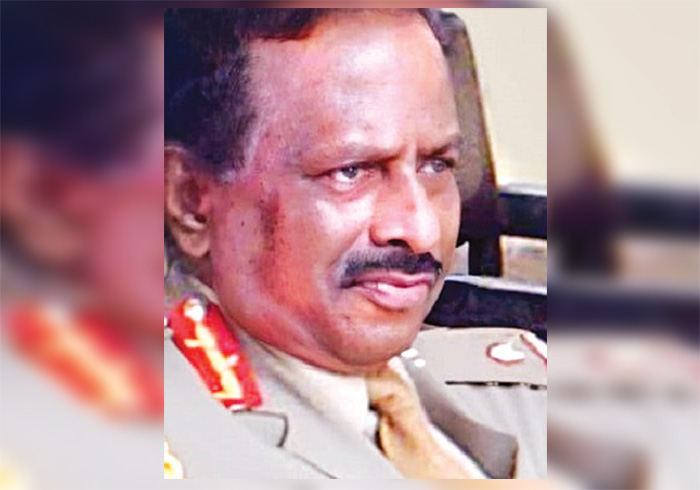
A forgotten story (part 1)
Colombo High Court Judge Adithya Patabendi, on March 27, 2025, acquitted former ASP Kulasiri Udugampola, who had been indicted over the Kandy police raid on a safe house run by the Directorate of Military Intelligence (DMI) at the Millennium City housing complex, Athurugiriya. The raid, conducted in the first week of January 2002, sent shock waves through the defence establishment. Delivering the judgment, 23 years after the raid, Patabendi declared that the prosecution failed to prove the charges beyond a reasonable doubt.
The Dec. 5, 2001 parliamentary election was conducted at the height of the war in the North. Having gained the upper hand in the battlefield, the LTTE was working on a Ceasefire Agreement with Norway. The country was in turmoil with President Chandrika Bandaranaike Kumaratunga, who survived an LTTE suicide blast at the final rally of her Dec. 1999 presidential election campaign, struggling to overcome a sustained UNP offensive.
In the run-up to the Dec. 5, 2001 parliamentary polls, UNP leader, Ranil Wickremesinghe accused the Directorate of Military Intelligence (DMI) of planning to assassinate him. The UNPer claimed that the DMI was training Tamil terrorists at the Panaluwa Army Testing Range to mount an attack on his campaign bus, as well as his political rallies.
The unprecedented accusation placed the war-weary Army in an extremely embarrassing position when it was actually turning tables on the enemy using its own tactics in areas considered by then as being off limits for security forces. The UNP, with no shame, brazenly exploited the made-up threat as the main Opposition party and its allies, including a treacherous section of the media, stepped-up pressure on the Army to no end.
On the instructions of Wickremesinghe, UNP Chairman Charitha Ratwatte and Deputy Chairman Daya Palpola wrote a hard-hitting letter to Army Commander, Lt. Gen. Lionel Balagalle warning that he would be held responsible ‘in the event of an unfortunate incident’. The UNP duo accused the Army chief of training personnel to engage in a destabilisation campaign against the UNP.
An irate Army Commander, Lt. Gen. Balagalle in reply addressed a letter to Ratwatte and Palpola dismissing their accusations. The Island, in a front-page exclusive headlined ‘Army chief says no truth in UNP claims,’ in its Nov, 11, 2001 edition that revealed the exchange between Army headquarters and Sirikotha.
The report was based on what Lt. Gen. Balagalle had told this writer the previous evening. The Army chief, himself a one-time head of the Directorate of Military Intelligence (DMI), said that there was absolutely no basis for the UNP allegation that a hit squad was undergoing training in the use of high explosives and thermobaric weapons to attack Wickremesinghe.
The UNP ignored the Army chief’s letter. The allegation was repeated throughout the campaign. The raid on the DMI safe-house should be examined against the backdrop of the exchange between the Army commander and Sirikotha.
It was somewhat reminiscent of the JVP tactic to tarnish all others who had ruled the country since independence as being A Grade crooks to come to power with a record majority they couldn’t have even dreamt of knowing their sordid past. The trick was to repeat a lie long enough with the help of Western funded international and local NGO quislings and the gullible masses believed it.
Amidst a furore over the UNP allegation that the Army conspired to assassinate Wickremesinghe, Army operatives blew up a truck behind enemy lines killing five LTTE cadres on Dec. 11, 2001. Then again, they destroyed an LTTE bunker, at the entrance to a base used by Karuna, in the Kokkadicholai area, on Dec. 21, 2001.
Although the Army had conducted a successful small group operation in the Batticaloa District, targeting a key LTTE operative identified as David, way back in 1992, there was no attempt on the part of the military to develop the capability further. But some officers had been keen to promote small group operations to weaken the LTTE and beat it at its own game.
Commenting on the elimination of David, a veteran in clandestine operations told the writer of the deep penetrations ops: “Three personnel took part in the targeted killing of David. They returned to base after achieving the given task. Such operations caused chaos in enemy territory which gave us the psychological advantage over them. We knew of the importance as well as the need to strike within the enemy-controlled areas, though a special strategy on clandestine operations was adopted only in 2001, almost a decade after the hit on David.”
Speaking on condition of anonymity, the soft-spoken official explained the circumstances under which the Army launched deep penetration units soon after one-time Director of the DMI Lionel Balagalle had been appointed Commander of the Army.
Balagalle couldn’t resist the temptation to explore the possibility of infiltrating areas outside government controlled regions to launch attacks. “It was a tremendous task. Those who volunteered to join the operation realised the risks they were taking. They were among the best and they courageously adopted the new doctrine, which enabled us to carry out targeted killings. It was nothing but a high risk operation, though it produced results. They had to curtail their movements, particularly in the Eastern Province, where we used Batticaloa as the centre of our operations.”
Then Brigadier Kapila Hendarawithana executed the operation in his capacity as Director of DMI.
The LTTE realised the danger. Within months after the launch of the first DMI raid in the Batticaloa District, the LTTE pushed for the suspension of the DMI operation. The February 23, 2002 Ceasefire Agreement (CFA), arranged by the Norwegians, included a clause which specifically dealt with DMI action. The CFA called for the suspension of operations behind LTTE lines. While the LTTE had been successful in its negotiations with the Norwegians and the then inept UNP government with Executive President Chandrika Kumaratunga reduced to more or less a figurehead, the DMI suffered a debilitating setback when that regime with hardly any feelings for our valiant fighting men risking their lives day and night, ordered a police raid on an Army safe-house used by a deep penetration team at Athurugiriya.
The UNP-led United National Front (UNF) emerged victorious at the Dec. 5, 2001 general election with 109 seats, while the defeated PA managed to secure 77 seats. The remaining seats were shared by the JVP (16), the TNA (15), the SLMC (5), the EPDP (2) and the DPLF (01).
Balgalle on ops behind enemy lines
It had been one of the bloodiest elections with the five-week campaign claiming the lives of almost 50 people, with the polls day massacre of a group of SLMC supporters at Udathalawinna being the single worst incident. This massacre carried out by troops attached to the Vijayaba Infantry Regiment (VIR) who had been brought to Kandy at the behest of de facto Defence Minister Anuruddha Ratwatte was used as an excuse by a vindictive UNP leadership to order the raid on the safe house used by the DMI situated at Millennium City, Athurugiriya, on Jan. 2, 2002, which changed the course of the conflict. The UNF cited intelligence reports that Anuruddha Ratwatte’s sons, wanted in connection with the Udathalawinna massacre, were taking refuge at Athurugiriya.
Had the UNP leadership been a little cautious, it would never have publicly accused the Army of an assassination plot. Lt. Gen. Balagalle discussed the issues at hand with the writer. Operating hit squads behind enemy lines had been a key element in the Army’s strategy to give it a taste of its own medicine, the Army chief said at that time, alleging the then Opposition had failed to grasp what was going on. The Island quoted Lt. Gen. Balagalle as having said: “Had they quietly raised the issue with us and sought a clarification without playing politics with national security, the Athurugiriya fiasco could have been averted. Even ex-LTTE cadres were brought in for operations along with valuable input from civilian informants. We were successful due to many reasons such as training from Pakistani instructors. We also accommodated troops from other fighting battalions to engage in operations behind enemy lines, though the Special Forces and Army Commandos spearheaded the campaign.”
At the time troops had been undergoing training in Pakistan, Balagalle functioned as Security Forces Commander, Jaffna.
The Athurugiriya raid ruptured relations between the UNP and the Army. It caused irreparable damage to national security. At the behest of the UNP, a section of the media, including the Colombo-based correspondents working for international news agencies, highlighted the Athurugiriya raid speculating the Army’s alleged involvement in anti-government activities. Investigating officers alleged that those who had been based at Athurugiriya were involved in the alleged attempt to assassinate Wickremesinghe. Subsequently, the DMI was accused of planning attacks in the city and its suburbs to sabotage the Norwegian-led peace process.
The UNP allegations had the desired impact in the wake of state television showing recovered items, which included 66 sets of LTTE uniforms, four thermobaric weapons, seven claymore mines each weighing 10 kgs, 10 claymore mines, each weighing one kg each, three T-56 assault rifles along with 400 rounds of ammunition, 10 anti-tank weapons, detonators, cyanide capsules, exploders, remote controlled devices and wire rolls.
While a section of the media lashed out at the Army, in a front-page exclusive headlined ‘Controversy over police raid on army officers Millennium City residence,’ on Jan 4, 2002, The Island revealed that a police team from Kandy, led by die-hard UNP loyalist, Kulasiri Udugampola, had raided an Army safe house. The raid also involved a team of CCMP (Ceylon Corps of Military Police).
In spite of both Lt. Gen. Balagalle and the then Director of DMI, Brigadier Kapila Hendawitharana (later served as Chief of National Intelligence, before quitting in 2015) reassuring the government of the legitimacy of operations undertaken by the DMI, the police was let loose on covert operatives. Regardless of Balagalle rushing Hendarawithana, who later figured in many controversies to the scene, Udugampola went ahead with the raid. The police had obtained permission from courts to search the premises.
Udugampola had the backing of the then Interior Minister, John Amaratunga. IGP Lucky Kodituwakku, though being convinced of the legitimacy of the DMI operation, couldn’t do anything. He was helpless.
Army takes firm stand
The Kandy police raided the safe house shortly after the officer-in-charge of the DMI operation had handed over part of their arsenal. Those involved in the hit-and-run operations in LTTE held-areas had returned to Colombo on Dec. 27, 2001, in the wake of the Wickremesinghe administration declaring its readiness to go ahead with a Norwegian initiative to sign a one-sided CFA clearly favourable to the LTTE. The Kandy police also accused the Army of planting two claymore mines targeting a UNP candidate along the Wattegama-Panwila road, in the run-up to the Dec. 5, 2001 polls.
The then security forces spokesman, Brig. Sanath Karunaratne emphasised that those who operated from Athurugiriya were involved in ‘Army duties’ (The Island Jan. 4, 2002). Regardless of protests by the Army, those arrested were taken away to the Narahenpita CMP headquarters before being transferred to Kandy. They were treated like criminals and held under humiliating conditions. Six of them, including an officer, were held in one room. For two weeks, the media reported all sorts of conspiracy theories.
Let me stress that the Athurugiriya betrayal, in a way divided the Army. An influential section of the Army obviously cooperated with the conspirators.
Those who had been arrested were held for almost two weeks before being granted bail. The police raid would never have been possible without an influential section within the Army cooperating with the political establishment to undermine a vital operation, which brought the LTTE under immense pressure.
The UNP and the police justified Udugampola’s raid. Asked whether he had used the safe house to accommodate his sons, one-time Defence chief, Anuruddha Ratwatte, candidly acknowledged that he hadn’t been among those who knew of the existence of that particular rear base, though the Army kept him informed of operations undertaken by the DMI. (Feb. 1 issue of The Island, 2002)
Marapana to the rescue
Then Defence Minister, Tilak Marapana, a one-time Attorney General, to his credit did not play politics with such an important issue and thwarted an attempt by the Kandy police to prolong the detention of DMI operatives using the provisions of the PTA to please their then political masters in the UNP. The bid to neutralize the DMI was made ahead of the signing of the CFA. The Wickremesinghe administration didn’t even bother to consult the armed forces and police top brass regarding the provisions of the agreement. Then Navy Commander, Vice Admiral Daya Sandagiri told the Lessons Learnt and Reconciliation Commission (LLRC) how then Defence Secretary, Austin Fernando, had bypassed them with regard to sensitive military issues.
Fernando, in an article captioned ‘The Peace Process and Security Issues’ (Negotiating Peace in Sri Lanka: Efforts, Failures and Lessons) admitted that the refusal on the part of the then government to consult the military had been a failure. Fernando said (page 42): “The military chiefs weren’t consulted in the drafting of the CFA. Of course, a casual opportunity was given to them to discuss the draft with Ministers of Defence (Tilak Marapana) and Constitutional Affairs (Prof. G.L. Peiris). This wasn’t considered adequate by them as they didn’t get an opportunity to discuss the CFA with their senior officers”.
The CFA declared that ACTIVITIES BY DEEP PENETRATION UNITS should be ceased along with the cessation of all military action. The LTTE wouldn’t have demanded a ban on DMI operations unless the group acknowledged the growing threat posed by DMI. The LTTE had been vulnerable to those hunting them in their own backyard. Obviously, the LTTE wouldn’t have bothered about the DMI had the latter been stalking Wickremesinghe in the run-up to the Dec. 2001 polls.
Retired Senior DIG Merril Gunaratne, who had been Defence Advisor to Wickremesinghe during the CFA, exposed the UNP leadership in his ‘COP IN THE CROSSFIRE.’ The first book of its kind, written by one-time Director General of Intelligence, revealed how the top UNP leadership took security issues lightly at the expense of the country as well as the party. Asked whether he had been involved in the operation to move the Kandy police against the DMI, Gunaratne told the writer at that time he categorically opposed the move. “I was convinced the PA government wouldn’t target Wickremesinghe, thereby allowing the UNP to benefit from the sympathy vote. Unfortunately, Wickremesinghe and his top advisors felt the Army was hell bent on destroying the UNP.”
Ex-LTTE’s among the slain
The Athurugiriya raid had a catastrophic impact on the armed forces, which experienced untold hardships due to miscalculations on the part of political and military leaders. Following the betrayal of the DMI, the LTTE unleashed a series of operations in the city, its suburbs and in the Eastern Province. Altogether, over 50 military personnel, Tamil informants as well as ex-LTTE cadres working for the Army, died at the hands of the LTTE as their identities were revealed owing to the raid on the army safe house. Wijayanadan Widyatharan, alias Vidya, of Sea Road, Navakkudah, was the first operative killed by the LTTE after exposure of the Athurugiriya operation. Vaidya was abducted on January 20, 2002, over two weeks after the raid.
The dead included two senior military officers, both killed in Colombo. Although the two military officials, holding the rank of Major and Colonel could have been on a hit list, regardless of the Athurugiriya fiasco, the LTTE exploited the situation to demoralise the Army. Daring operations directed at the DMI and police intelligence helped boost the LTTE’s image. The military was placed in an unenviable position as the suspension of the PTA effectively neutralised counter-measures directed at LTTE hit squads.
Inspector Dale Gunaratne, the then President of the Police Inspectors’ Association, was perhaps the only law enforcement officer publicly critical of the UNP’s response to the LTTE threat. (Having retired years ago, Gunaratne now serves as an Attorney-at-Law) Although his superiors reacted angrily, Gunaratne lashed out at the government for allowing the LTTE to exploit the CFA to its advantage. Citing the killing of Inspector Thabrew at the Dehiwela Police Station, in July 2003, IP Gunaratne alleged that the suspension of the PTA in keeping with the CFA was nothing but a grievous threat to those fighting terrorism. He kept on lambasting the UNP and his own superiors for not taking action to neutralise the LTTE threat. But the UNP was determined to salvage the crumbling peace process at any cost. For those at the helm of the government, the lives of security forces and police didn’t matter, as long as they believed the LTTE would remain in the negotiating process. Politicians felt whatever the provocations, the peace process should continue.
By Shamindra Ferdinando
Midweek Review
Universal in a Catastrophe
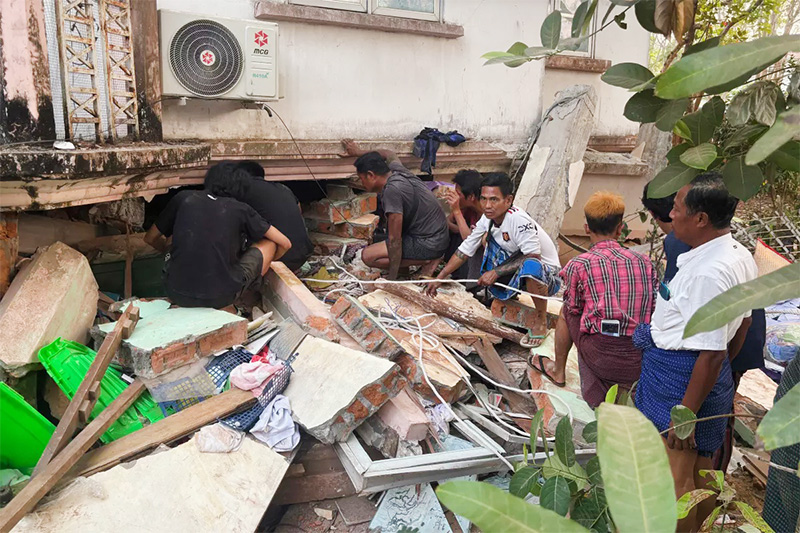
Survivors of the South-East Asian tragedy,
Triggered by nature’s stern promptings,
Somehow reining-in suffocating sorrow,
Are leaving no unhinged stone unturned,
To salvage the remains of those held dear,
In fresh testimony of love’s staying power,
But it speaks well for the untouched majority,
That unstinted succor is pouring in,
To render some solace to the hapless,
Although no amount of fellow feeling,
Could make up for the wrenching sorrow,
Of parting from a priceless presence.
By Lynn Ockersz
Midweek Review
Batalanda and complexities of paramilitary operations
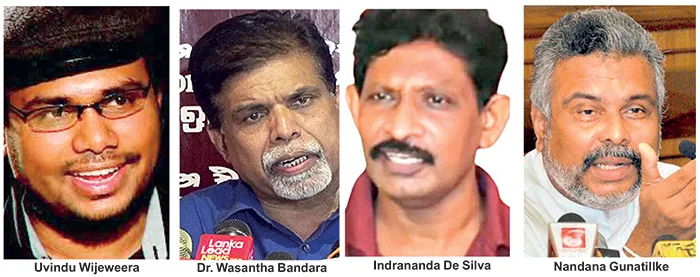
Former President Ranil Wickremesinghe’s recent combative ‘Head-to-Head’ interview with British-American Mehdi Hasan on Al Jazeera has opened a can of worms. As to why Hasan raised the Batalanda Presidential Commission report, during a 49-minute interview conducted at the London’s Conway Hall, with a clearly pro LTTE audience, remains a mystery. This must be yet another notorious way to show how even-handed they are as in the case of its coverage of Russia, China, Palestine or Ukraine for their gullible viewers.
Recorded in February and aired in March 2025, the interview is definitely the most controversial the UNP leader, who is also an Attorney-at-Law, ever faced during his political career; always used to getting kid glove treatment, especially after taking over the party in 1994.
The continuing public discourse on Batalanda should provoke a wider discussion on Sri Lanka’s response to separatist Tamil terrorism, since the cold blooded murder of Jaffna SLFP Mayor Alfred Duriappah, which signalled the beginning of the LTTE terror campaign that ended in May 2009 with the crushing military defeat of the Tigers on the banks of the Nathikadal lagoon, as well as two southern insurgencies in 1971 and 1987-1990.
As Nandana Gunatilleke (one time JVP General Secretary and ex-MP), Dr. Wasantha Bandara (ex-JVPer and close associate of the slain JVP leader Rohana Wijeweera), Indrananda de Silva (ex-JVPer, incumbent Central Committee member of Frontline Socialist Party [FSP] and ex-military photographer) and Uvindu Wijeweera (Rohana Wijeweera’s son and leader of Dewana Parapura) agreed during the recent Hiru ‘Balaya’ discussion, conducted by Madushan de Silva, the Batalanda operation was in line with the overall counter-terrorist/insurgency strategy of the then government.
The issues at hand cannot be discussed at all without taking into consideration the JVP terrorism that, at one-time, almost overwhelmed the UNP’s unbroken rule, since 1977, carried out while openly brushing aside most of the universally accepted genuine parliamentary norms. The country’s second Republican constitution, promulgated by the UNP regime with a 5/6 majority in Parliament, in 1978, had been amended no less than 13 times by the time they were finally ousted in 1995. This was mainly to facilitate their continuous rule. Unfortunately, all stakeholders have sought to take advantage of Batalanda, thereby preventing a proper dialogue. Quite surprisingly, none of the guests, nor the interviewer, bothered, at least, to make a reference to the JVP bid on President J.R. Jayewardene’s life in Parliament on the morning of July 18, 1987. At the time, JVPer Ajith Kumara, working in the House as a minor employee, hurled two hand grenades towards JRJ, with the then Prime Minister Ranasinghe Premadasa seated next to JRJ. While one government MP lost his life, several others suffered injuries, including then National Security Minister Lalith Athulathmudali, whose spleen had to be removed.
At one point, Gunatilleke declared that they assassinated UNP MP for Tangalle Jinadasa Weerasinghe on July 3, 1987, in response to the government killing well over 100 people, in Colombo, protesting against the signing of the Indo-Lanka accord on July 29, 1987. The parliamentarian was killed near the Barawakumbuka-Welangahawela bridge on the Colombo-Rathnapura-Embilipitiya Road. The UNPer was killed on his way home after having declined Premier Premadasa’s offer to make an SLAF chopper available for him to reach home safely.
Against the backdrop of MP Weerasinghe’s assassination and the grenade attack on the UNP parliamentary group that claimed the life of Keethi Abeywickrema (MP for Deniyaya), the government had no option but to respond likewise. The operation, established at the Batalanda Housing scheme of the State Fertiliser Corporation, constituted part of the counter-insurgency strategy pursued by the UNP.
Those who called Batalanda complex Batalanda torture camp/ wadakagaraya conveniently forgot during the second JVP inspired insurgency, the military had to utilize many public buildings, including schools, as makeshift accommodation for troops. Of course the UNP established Batalanda under different circumstances with the then Industries Minister Ranil Wickremesinghe providing political authority. Batalanda had been an exclusive police operation though the Army had access to it whenever a requirement arose.
Those who had been suddenly withdrawn from the Northern and Eastern Provinces, to meet the rapidly evolving security threat in the South, required accommodation. FSP CC member Indrananada de Silva had received unhindered access to Batalanda in his capacity as a military photographer and the rest is history.
As to why Indrananda de Silva switched his allegiance to the FSP should be examined, taking into consideration his previous role as a trusted military photographer, formerly a Lance Corporal of the Military Police. An influential section of the JVP, led by Kumar Gunaratnam, formed the FSP in April 2012 though it didn’t receive the much anticipated public support. Both Indrananda de Silva and Nandana Gunatilleke, who aligned himself with the UNP, found fault with the JVP-led National People’s Power (NPP) over its handling of the Batalanada issue.
Paramilitary operations
Paramilitary operations had been an integral part of the overall counter-insurgency campaign, directed at the JVP responsible for approximately 6,600 killings. Among those death squads were PRRA primarily drawn from the SLMP (Sri Lanka Mahajana Party) and SRRA (the socialist Revolutionary Red Army). PRRA had close links with the Independent Student Union (ISU) whose leader Daya Pathirana was slain by the JVP. The vast majority of people do not remember that Daya Pathirana, who led the ISU during the turbulent 1985-1986 period, was killed mid-Dec. 1989. The second insurgency hadn’t started at that time though the JVP propagated the lie that they took up arms against the UNP government following the signing of the Indo-Lanka peace accord on July 29, 1987.
In addition to PRRA and SRRA, the government made use of paramilitary groups, namely Kalu balallu, Ukkusso, Rajaliyo, Kaha balallu, Kola koti, Rathu Makaru, Mapila, Gonussa, Nee, Keshara Sinhayo, Le-mappillu and Kalu koti.
The UNP also involved some elements of Indian trained Tamil groups (not of the LTTE) in paramilitary operations. Such operations, that had been backed by respective Cabinet Ministers, were supervised by local law enforcement authorities. Paramilitary operations had been in line with psychological warfare that was meant to cause fear among the JVP, as well as the general population. Military operations that had been combined with paramilitary actions received the blessings of the political leadership at the highest level. In the case of Batalanda (1988-1990) President J.R. Jayewardene and Ranasinghe Premadasa knew of its existence.
Even after the eradication of the top JVP leadership, by Nov. 1989, police, military and paramilitary operations continued unabated. Former JVPers appearing on ‘Balaya’ agreed that counter-insurgency operations were actually brought to an end only after D.B. Wijetunga succeeded President Ranasinghe Premadasa after the latter’s assassination on May Day 1993.
After the LTTE resumed war in June 1990, just a couple of months after the withdrawal of the Indian Army (July 1987-March1990), the UNP authorized paramilitary operations in the northern and eastern areas. Members of TELO, PLOTE, EPRLF as well as EPDP were made part of the overall government security strategy. They operated in large groups. Some paramilitary units were deployed in the Jaffna islands as well. And these groups were represented in Parliament. They enjoyed privileged status not only in the northern and eastern regions but Colombo as well. The government allowed them to carry weapons in the city and its suburbs.
These groups operated armed units in Colombo. The writer had the opportunity to visit EPDP and PLOTE safe houses in Colombo and its suburbs soon after they reached an understanding with President Ranasinghe Premadasa. Overnight at the behest of President Premadasa, the Election Department granted these Tamil groups political recognition. In other words, armed groups were made political parties. The Premadasa government accepted their right to carry weapons while being represented in Parliament.
It would be pertinent to mention that thousands of Tamil paramilitary personnel served the government during that period. There had been many confrontations between them and the LTTE over the years and the latter sought to eliminate key paramilitary personnel. Let me remind you of the circumstances, the EPRLF’s number 02 Thambirajah Subathiran alias Robert was sniped to death in June 2003. Robert was engaged in routine morning exercises on the top floor of the two-storeyed EPRLF office, on the hospital road, Jaffna, when an LTTE sniper took him out from the nearby Vembadi Girls’ high school. The operation of the Norway managed Ceasefire Agreement (CFA) made no difference as the LTTE removed Robert who led the party here in the absence of leader Varatharaja Perumal, the first and the only Chief Minister of the North-Eastern Province.
In terms of the CFA that had been signed by Premier Ranil Wickremesinghe and LTTE leader Velupillai Prabhakaran, in Feb. 2002, the government agreed to disarm all paramilitary personnel. Many wouldn’t remember now that during Premadasa’s honeymoon with the LTTE, the Army facilitated the LTTE onslaught on paramilitary groups in selected areas.
Muthaliff’s role
During the ‘Balaya’ discussion, the contentious issue of who shot JVP leader Rohana Wijeweera came up. Nandana Gunatilleke, who contested the 1999 Dec. presidential election. as the JVP candidate, pointing to an article carried in the party organ that dealt with Wijeweera’s assassination said that he wrongly named Gaffoor as one of the persons who shot their leader whereas the actual shooter was Muthaliff. The headline named Thoradeniya and Gaffoor as the perpetrators.
Declaring that he personally wrote that article on the basis of information provided by Indrananda de Silva, Gunatilleke named Asoka Thoradeniya and Tuan Nizam Muthaliff of the Army as the perpetrators of the crime. Thoradeniya served as Sri Lanka’s High Commissioner in the Maldives during the Yahapalana administration, while Muthaliff was killed by the LTTE in Colombo in late May 2005. The shooting took place at Polhengoda junction, Narahenpita. Muthaliff was on his way from Manning town, Narahenpita, to the Kotelawala Defence University.
The programme was told that the JVP had over the years developed close relationship with Thoradeniya while Indrananda de Silva accused Dr. Wasantha Bandara of duplicity regarding Muthaliff. How could you recognize Muthaliff, slain by the LTTE, as a war hero as he was actually one of the persons who shot Rohana Wijeweera, the latter asked.
At the time of his assassination, Muthaliff served as the Commanding Officer, 1 st Regiment Sri Lanka Military Intelligence Corps. The then parliamentarian Wimal Weerawansa was among those who paid last respects to Maj. Muthaliff.
At the time of Rohana Wijeweera’s arrest, Muthaliff served as Lieutenant while Thoradeniya was a Major. Indrananda de Silva strongly stressed that atrocities perpetrated by the police and military in the South or in the northern and eastern regions must be dealt with regardless of whom they were conducting operations against. The former JVPer recalled the Army massacre in the east in retaliation for the landmine blast that claimed the lives of Northern Commander Maj. Gen. Denzil Kobbekaduwa and a group of senior officers, including Brigadier Wijaya Wimalaratne, in early Aug. 1990 in Kayts.
Dr. Wasantha Bandara warned of the Western powers taking advantage of what he called false narrative to push for a Truth and Reconciliation Commission.
It would be pertinent to mention that the LTTE also used the underworld as well as some corrupt Army personnel in planning high profile assassinations. Investigations into the assassination of Muthaliff, as well as Maj. Gen. Parami Kulatunga, killed in a suicide attack at Pannipitiya, in June 2006, revealed the direct involvement of military personnel with the LTTE.
Indrananda de Silva disclosed that soon after Anura Kumara Dissanayake won the presidential election last September, the FSP, in writing, requested the JVP leader to inquire into killings during that period, including that of Rohana Wijeweera. The FSPer alleged that President Dissanayake refrained from even acknowledging their letter. Indrananda de Silva emphasized that Al Jazeera never disclosed anything new as regards Batalanda as he exposed the truth years ago. The former JVPer ridiculed the ruling party tabling the Batalanda Commission report in the wake of Wickremesinghe’s Al Jazeera interview whereas the matter was in the public domain for quite some time.
Indrananda de Silva and Nandana Gunatilleke exchanged words over the latter’s declaration that the JVP, too, was subjected to investigation for violence unleashed during the 1987-1990 period. While the FSPer repeatedly declared that those who carried out directives issued by the party were arrested and in some cases killed, Nandana Gunatilleke took up the position that the party should be held accountable for crimes perpetrated during that period.
The interviewer posed Nandana Gunatilleke the question whether he was betraying his former comrades after joining the UNP. Nandana Gunatilleke shot back that he joined the UNP in 2015 whereas the JVP joined UNP as far back as 2009 to promote retired Army Chef Sarath Fonseka’s presidential ambition even though he wiped out the JVP presence in Trincomalee region during the second insurgency.
JVP’s accountability
Nandana Gunatilleke is adamant that the party should accept responsibility for the killings carried out at that time. The former JVPer declared that Vijaya Kumaratunga (Feb. 16, 1988), first Vice Chancellor of the Colombo University (March 08, 1989) Dr. Stanley Wijesundera, Ven. Kotikawatte Saddhatissa thera (Aug. 03, 1988) and Chairperson of the State Pharmaceutical Corporation Gladys Jayewardene (Sept. 12, 1989) were among those assassinated by the JVP. SPC Chairperson was killed for importing medicine from India, the former Marxist aligned with the UNP said, while actor-turned-politician Kumaratunga’s assassination was attributed to his dealings with President J.R. Jayewardene.
According to Nandana Gunatilleke, except for a few killings such as General Secretaries of the UNP Harsha Abeywickrema (Dec 23, 1987) and Nandalal Fernando (May 20, 1988), the vast majority of others were ordinary people like grama sevakas killed on mere accusation of being informants. The deaths were ordered on the basis of hearsay, Nandana Gunatilleke said, much to the embarrassment of others who represented the interest of the JVP at that time.
One quite extraordinary moment during the ‘Balaya’ programme was when Nandana Gunatilleke revealed their (JVP’s) direct contact with the Indian High Commission at a time the JVP publicly took an extremely anti-Indian stance. In fact, the JVP propagated a strong anti-Indian line during the insurgency. Turning towards Dr. Wasantha Bandara, Gunatilleke disclosed that both of them had been part of the dialogue with the Indian High Commission.
It reminds me of the late Somawansa Amarasinghe’s first public address delivered at a JVP rally in late Nov. 2001 after returning home from 12 years of self-imposed exile. Of the top JVP leadership, Somawansa Amarasinghe, who had been married to a close relative of powerful UNP Minister Sirisena Cooray, was the only one to survive combined police/military/paramilitary operations.
Amarasinghe didn’t mince his words when he declared at a Kalutara rally that his life was saved by Indian Premier V.P. Singh. Soft spoken Amarasinghe profusely thanked India for saving his life. Unfortunately, those who discuss issues at hand conveniently forget crucial information in the public domain. Such lapses can be both deliberate and due to negligence.
By Shamindra Ferdinando
-

 Sports4 days ago
Sports4 days agoSri Lanka’s eternal search for the elusive all-rounder
-
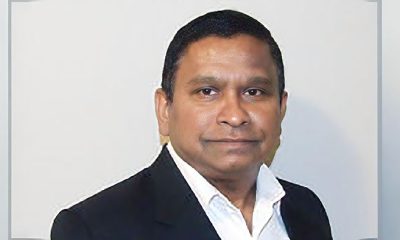
 News3 days ago
News3 days agoBid to include genocide allegation against Sri Lanka in Canada’s school curriculum thwarted
-
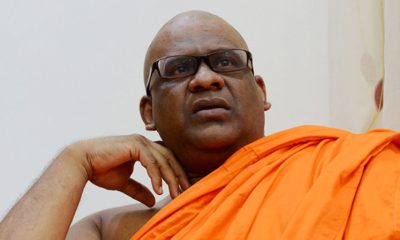
 News5 days ago
News5 days agoGnanasara Thera urged to reveal masterminds behind Easter Sunday terror attacks
-
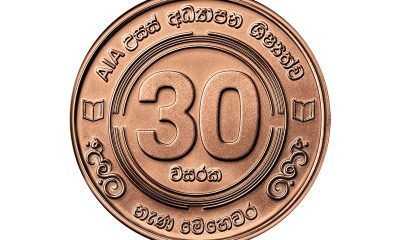
 Business6 days ago
Business6 days agoAIA Higher Education Scholarships Programme celebrating 30-year journey
-
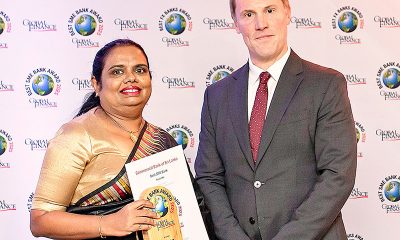
 News4 days ago
News4 days agoComBank crowned Global Finance Best SME Bank in Sri Lanka for 3rd successive year
-
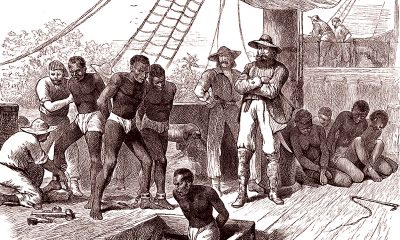
 Features4 days ago
Features4 days agoSanctions by The Unpunished
-

 Latest News2 days ago
Latest News2 days agoIPL 2025: Rookies Ashwani and Rickelton lead Mumbai Indians to first win
-
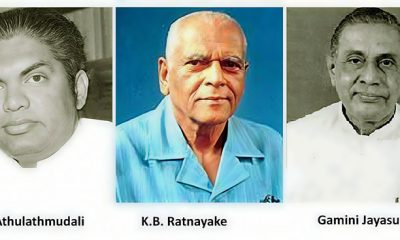
 Features4 days ago
Features4 days agoMore parliamentary giants I was privileged to know











